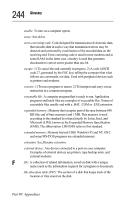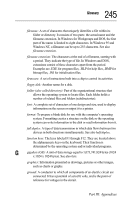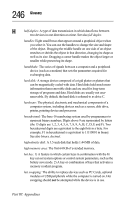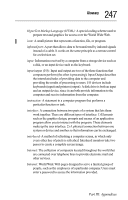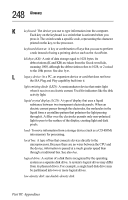Toshiba 8000 Tecra 8000 Users Guide - Page 272
light emitting diode LED, double-density disk
 |
UPC - 032017021280
View all Toshiba 8000 manuals
Add to My Manuals
Save this manual to your list of manuals |
Page 272 highlights
248 Glossary K keyboard: The device you use to type information into the computer. Each key on the keyboard is a switch that is activated when you press it. The switch sends a specific code, representing the character printed on the key, to the processor. keyboard shortcut: A key or combination of keys that you use to perform a task instead of using a pointing device such as the AccuPoint. kilobyte (KB): A unit of data storage equal to 1024 bytes. Its abbreviations (K and KB) are taken from the Greek word kilo, meaning 1000, although the abbreviation refers to 1024, or 2 raised to the 10th power. See also byte. L legacy device: In a PC, an expansion device or card that does not have the ISA Plug and Play capability built into it. light emitting diode (LED): A semiconductor device that emits light when it receives an electric current. Used for indicators like the disk activity light. liquid crystal display (LCD): A type of display that uses a liquid substance between two transparent electrode panels. When an electric current passes through the electrodes, the molecules in the liquid form a crystalline pattern that polarizes the light passing through it. A filter over the electrodes permits only non-polarized light to pass to the surface of the display, creating light and dark pixels. load: To move information from a storage device (such as a CD-ROM) into memory for processing. local bus: A type of bus that connects devices directly to the microprocessor. Because there are no wires between the CPU and the device, information is passed at a much greater speed than through a traditional bus. See also bus. logical drive: A section of a disk that is recognized by the operating system as a separate disk drive. A system's logical drives may differ from its physical drives. For example, a single hard disk drive may be partitioned into two or more logical drives. low-density disk: see double-density disk. Part III: Appendixes




